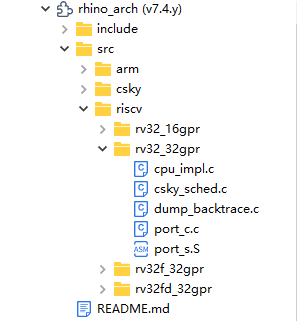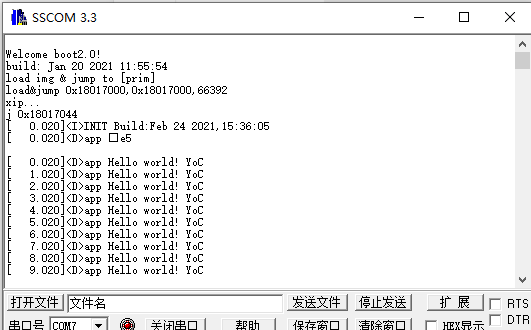RVB2601 应用开发实战系列一: Helloworld 最小系统
RVB2601 应用开发实战系列一: Helloworld 最小系统关键词:RVB2601、RISC-V 开发板、例程,低功耗,玄铁 E906,RISC-V MCU,上手,好用,控制,WiFi&BLE
1.引言
RVB2601 开发板是基于 CH2601 芯片设计的生态开发板,其具有丰富的外设功能和联网功能,可以开发设计出很多有趣的应用。为了开发者更好的了解如何在 CH2601 上开发应用,本文介绍了如何移植对接 CH2601 芯片到 YoC 最小系统,开发第一个我的 helloworld 程序。
整个开发移植工作,我们都全部基于剑池 CDK 集成开发环境进行开发。剑池 CDK 以极简开发为理念,是专业为 IoT 应用开发打造的集成开发环境。它在不改变用户开发习惯的基础上,全面接入云端开发资源,结合 图形化的 OSTracer、Profiling 等调试分析工具,加速用户产品开发。想要了解更多剑池 CDK 开发信息,请前往平头哥芯片开发社区里集成开发环境获取更多。
建议在在看本文之前,先详细看下RVB2601开发板快速上手教程。本例程名为 ch2601_helloworld_demo,可以通过 CDK 直接从 OCC 拉取。
2.最小系统移植适配
YoC 最小系统包括对 AliOS Things 内核的移植,涉及到任务切换时的处理器上下文保存和恢复 ,中断事件处理,时钟心跳初始化等。利用一个任务不断周期性的打印"Helloworld"来演示最小系统移植成功。
2.1 适配 YoC 内核
进入 ch2601_helloworld 目录,打开工程文件,所有的组件代码都位于 packages 节点下, 点击 packages 下的 rhino_arch 包。该组件包含了 ARM、CSKY、RISCV 等架构下的任务调度的代码,假如架构相同,则直接使用包内代码,若不存在,需要按照接口,将 port_s.S、port_c.c 等代码实现。具体目录结构如下图:

由于 CH2601 使用了 RISC-V 32bit 处理器, 我们使用 rv32_32gpr 的具体实现,根据 Kernel 的对接分为以下几个部分:
2.1.1 任务切换相关
cpu_intrpt_switch
该功能函数定义在 rhino_arch/src/riscv/rv32_32gpr/port_c.S 里, 主要用户触发软中断,切换任务。用户可以通过该接口来实现任务切换。
tspend_handler
该功能函数定义在 rhino_arch/src/riscv/rv32_32gpr/port_c.S 里, 作为 tspend 中断的处理函数接口,主要用于保存当前的任务上下文,切换将要运行的下一个任务后,恢复下一个任务上下文。
2.1.2 第一个任务初始化
cpu_first_task_start
该功能函数定义在 rhino_arch/src/riscv/rv32_32gpr/port_c.S 里, 作为第一个任务启动接口。用户通过调用该接口来实现第一个任务的启动。
cpu_task_stack_init
该功能函数定义在 rhino_arch/src/riscv/rv32_32gpr/port_c.c 里, 用于初始化第一个任务的的上下文,用户可以通过调用该接口来实现第一个任务的执行入口,输入参数等。
2.1.3 内核心跳时钟初始化
内核心跳时钟主要用于系统时钟的计时,系统任务的切换等。我们可以采用一个普通的定时器来做为系统心跳时钟。
SystemInit
该功能函数定义在 chip_ch2601/sys/system.c, 实现对整个系统的进行初始化,包括对系统内核时钟,CACHE 初始化等。
csi_tick_init
该功能函数在 chip_ch2601/sys/tick.c,实现内核心跳的初始化,通过回调函数 tick_event_cb 对系统时钟进行技术,同时通过调用 krhino_tick_proc 实现对系统任务的调度。
2.1.4 内核初始化
在任务启动前,需要对内核做初始化,最后调用 aos_start 来启动第一个任务。
aos_init
该功能函数位于 aos/src/main.c, 用于初始化内核,启动第一个任务。
aos_start
该功能函数用于启动内核,运行第一个任务。
至此,YoC 内核部分适配结束,编译通过后就可以进行 Helloworld 应用程序开发了。
2.2 开发 helloworld 程序
2.2.1 串口初始化
在 app/src/init/init.c 里完成 board 初始化函数里完成串口的初始化。
console_init
该功能函数用于串口的初始化。
ulog_init
该功能函数用于打印功能的初始化。
2.2.2 打印 Helloworld
最后在 main 函数里实现 helloworld 的循环打印。
2.3. 编译运行
编译通过后,下载到 RVB2601 开发板后复位运行(具体下载运行操作可以参考 RVB2601 开发板快速上手教程),看到串口窗口出现一下打印,说明移植成功。

3. 总结
RVB2601 最小系统 hellworld 主要实现对 YoC 系统的内核适配,具备 RTOS 的基本能力,实现简单的串口打印。后续还有更精彩的实战案例,敬请期待。
本文转自平头哥芯片开放社区(occ),更多详情请点击https://occ.t-head.cn/store/board?channelName=1。












评论